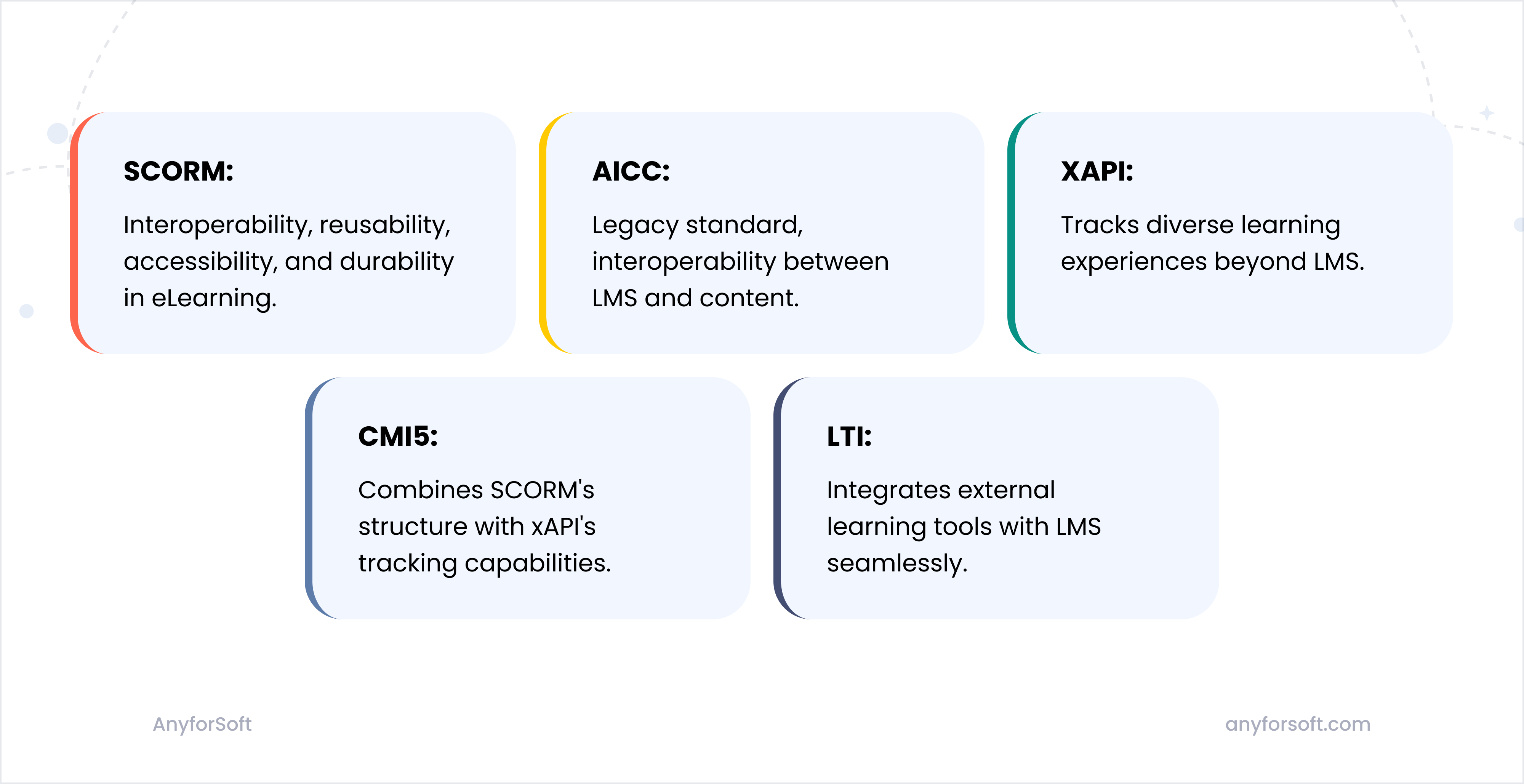You’ve probably noticed your industry is on fire lately, right? Well, let’s put some numbers to that feeling. Since 2000, the eLearning market has skyrocketed by an eye-popping 900%. But you already knew this business was booming – after all, you’re in the thick of it!
What might surprise you, though, is how widespread eLearning has become. These days, a whopping 99% of companies offer some form of online learning to their employees. That’s up from just 76% five years ago. If you’re feeling the pressure of increased competition, now you know why!
But here’s where things get really interesting for us insiders. This eLearning explosion isn’t just about slick marketing or fancy graphics. The real game-changers are the tech standards working behind the scenes: SCORM, xAPI, LTI, and cmi5. Each of these standards is unique and addresses different aspects of the learning experience making it really important. Therefore, online learning providers cannot neglect them.
Ready to geek out a bit? We’re about to break down how SCORM, xAPI, and cmi5 stack up against each other. We’ll even throw LTI and AICC into the mix. By the end of this, you’ll have a clear picture of which standards could give your eLearning business the edge it needs. Let’s get into it!
What are eLearning Standards?
eLearning standards are the basis of digital education. In fact, when we talk about standards, the first thing that might come to mind is traffic rules. As with transportation, eLearning standards define how your learning content is created, packaged, and delivered in the digital space. Following them, you can be sure that your course will work in most eLearning platforms and systems.
These content standards come with a superpower: tracking capabilities. They let you see how students tackle your learning materials, giving you the info you need to measure success and level up your courses. Some standards even jazz things up with gamification in e-Learning to keep students hooked. For anyone making online courses, these standards are gold. They’re your ticket to creating stuff that’s both effective and works across various learning management systems (LMS). Before we dive into the head-to-head comparisons, let’s take a quick tour of each standard individually.

What is SCORM?
SCORM, or Sharable Content Object Reference Model, is the heavyweight champion of eLearning standards. Ever wish your courses could work anywhere? That’s exactly what SCORM does. It helps you build SCORM-compliant content that fits right in with all sorts of learning systems. No fuss, no muss. With SCORM, you can package up your lessons, quizzes, and videos so they work smoothly across platforms. The real magic happens with tracking learning activity. With SCORM compliance, you can see how learners interact with your material, measure their progress, and even track quiz scores. There are different versions of SCORM, each with its quirks and features. But whether you’re using the older SCORM 1.1, 1.2, or the newer SCORM 2004, this standard helps you create courses that are flexible, trackable, and ultimately more valuable to your clients.
Pros and Cons of SCORM
Pros:
- Wide Adoption: SCORM is an industry standard, making it compatible with most learning platforms.
- Easy Sharing: SCORM content can be easily shared across different systems, saving time and money.
- Reliable Tracking: It tracks learner progress and assessment scores consistently.
- Authoring Tool Support: Most authoring tools create SCORM-compliant content out of the box.
- Consistent Experience: Learners get a similar experience across different platforms.
- Cost-Effective: Reusable SCORM content means less development time and cost.
Cons:
- Limited Offline Support: SCORM works best online, limiting offline learning options.
- Basic Analytics: While it tracks basics, it lacks advanced data analysis capabilities.
- Rigid Structure: The SCORM standard can be inflexible for some modern learning approaches.
What is xAPI?
Remember SCORM? xAPI, or Experience API, is like its cooler, more venturesome sibling. While SCORM was happy to stay at home inside the cozy LMS family, the xAPI was born to explore! It can track your learning journey whether you’re binge-watching how-to videos, playing around in virtual simulations, or even learning on the job. It’s as if you can see every angle of how people learn and improve, not just what goes on in the classroom.
At its core, xAPI, also known as Tin Can API, uses statements to record learning events. These statements follow a simple format: “Actor verb object.” For example, “John completed sales training.” xAPI statements are stored in a Learning Record Store (LRS), which can be part of an LMS or stand alone.
With this treasure trove of data provided by xAPI, companies can cook up learning programs that fit each person to a T. The result is learning that actually sticks and helps people succeed at their jobs.
Pros and Cons of xAPI
Pros:
- Comprehensive data capture: xAPI allows accessing learning data from different sources such as mobile apps and offline learning experiences.
- Advanced knowledge: An LRS can act as a data hub and allows you to track how people learn, what resources they use, and what these people find stimulating or undesirable.
- Flexible tracking: xAPI can be used to track all kinds of learning experiences, from traditional courses to exercising in team-based learning activities.
- Personalized learning: Rich data enables the creation of adaptive learning paths tailored to individual needs.
- Mobile-friendly: Unlike SCORM, xAPI easily captures data from mobile devices, supporting on-the-go learning.
Cons:
- Complex Setup: Configuring xAPI for accurate performance analytics can be time-consuming due to the need to measure data across multiple learning activities.
- Impact Measurement: xAPI tends to capture basic data, which is not always sufficient to measure the learning impact either qualitatively or/and quantitatively.
- Misconceptions About Functionality: Some expect xAPI to enhance course appearance or content automatically, but it merely changes the communication protocol without altering the course design or behavior.
What is LTI?
LTI, or Learning Tools Interoperability, is pretty much a universal adapter for education tech. In a few words, it allows different learning tools and platforms to talk to each other. You know how there are myriad online systems for all things teaching-related – the main school website or platform, the e-classroom, the quiz app, the virtual lab? LTI allows all these to come together and interconnect, combining and centralizing access in one main system. So, when talking of LTI, what we mean is taking various learning technologies and connecting them seamlessly.
Pros and Cons of LTI
Pros:
- Easy integration: LTI lets you plug in different learning tools without a headache, like adding Lego blocks to your learning platform.
- Cost-effective: You can add new features to your learning system without breaking the bank on custom e-Learning app development.
- Flexibility: Mix and match tools to create the perfect learning experience for your students or employees.
- Time-saver: Quick setup means less time fiddling with tech and more time actually teaching or learning.
Cons:
- Limited support: Not all learning platforms play nice with LTI, which can be a bummer if yours doesn’t.
- Potential UX issues: Sometimes, integrated tools might not look or feel quite right within your main platform.
- Data limitations: Some data sharing limitations might lead some to choose xAPI for more comprehensive data tracking.
What is cmi5?
What is cmi5 all about? Well, you can think of cmi5 as a blend of SCORM and xAPI. It’s like xAPI got a makeover to play nice with traditional LMS setups. Cmi5 brings structure to xAPI’s free-spirited nature, making it easier for e-learning content to work smoothly across different systems. cmi5 is a set of rules that makes e-learning content on-and-off different systems, platforms and devices. Thus with cmi5, you get the best of both worlds: xAPI’s flexibility and SCORM’s familiarity.
Pros and Cons of cmi5
Pros:
- Precise tracking: Offers detailed, standardized data on learner progress.
- LMS friendly: Plays nice with traditional learning management systems.
- Simplified implementation: Clearer rules make it easier to adopt than raw xAPI.
Cons:
- Less flexibility: More restrictions than pure xAPI.
- Limited adoption: Newer standard, so not as widely supported yet.
What is AICC?
AICC, which stands for Aviation Industry Computer-based Training Committee, is like the grandparent of e-learning standards. Born in the early 90s, it was the first attempt to create a universal language for online training. While it started in the aviation world, AICC quickly spread its wings to other industries. Although it’s now retired, AICC laid the groundwork for modern standards like SCORM and xAPI. It’s like the Wright brothers’ plane – not used anymore, but hugely important in the evolution of e-learning.
Pros and Cons of AICC
Pros:
- Deployment Flexibility: AICC allows hosting content on a different server than your LMS, offering more deployment options.
- High Security: AICC ensures secure HTTPS data transfers between learning content and the LMS, protecting sensitive information.
Cons:
- Obsolete Standard: AICC is no longer supported or updated, primarily used in legacy applications with no new content being created.
- Limited Functionality: Compared to modern standards, AICC lacks advanced features and progress-tracking capabilities.
- Compatibility Issues: AICC-compliant systems often miss essential features, requiring additional time and resources for manual coding.
Capabilities of xAPI, SCORM, LTI and cmi5
When building an e-Learning platform, understanding the strengths of existing standards is crucial. For instance, the difference between SCORM and xAPI capabilities is evident. xAPI opens the floodgates to endless employee training options, keeping tabs on learners whether they’re glued to screens or out in the real world.
SCORM, the old reliable, excels at tracking course completions and test scores in traditional online settings. It’s perfect for straightforward training needs.
LTI focuses more on integrating learning tools, whereas cmi5, the new kid on the block, combines xAPI’s flexibility with SCORM’s structure.
Each standard has its strengths, but let’s be honest, in the debate of SCORM vs xAPI vs AICC, it’s clear that xAPI’s ability to capture data from a variety of sources makes it a superior choice for modern learning environments.
Key differences between SCORM, xAPI, LTI and cmi5

Conclusion
While it may be difficult to navigate through e-learning standards, it is one of the steps toward powerful training courses. When comparing xAPI, you may find that it outperforms other standards in a number of ways. This is why content developers often prefer choosing xAPI. But this doesn’t mean you need to limit yourself to just one option. Many of the contemporary e-learning solutions use a mix of xAPI and SCORM as well as other standards to create robust, flexible learning environments.
Whether you’re tackling this solo or teaming up with experts like AnyforSoft for e-learning software development services, understanding the nuances of xAPI vs SCORM and other specifications ensures you can select the best fit for your e-learning goals.








